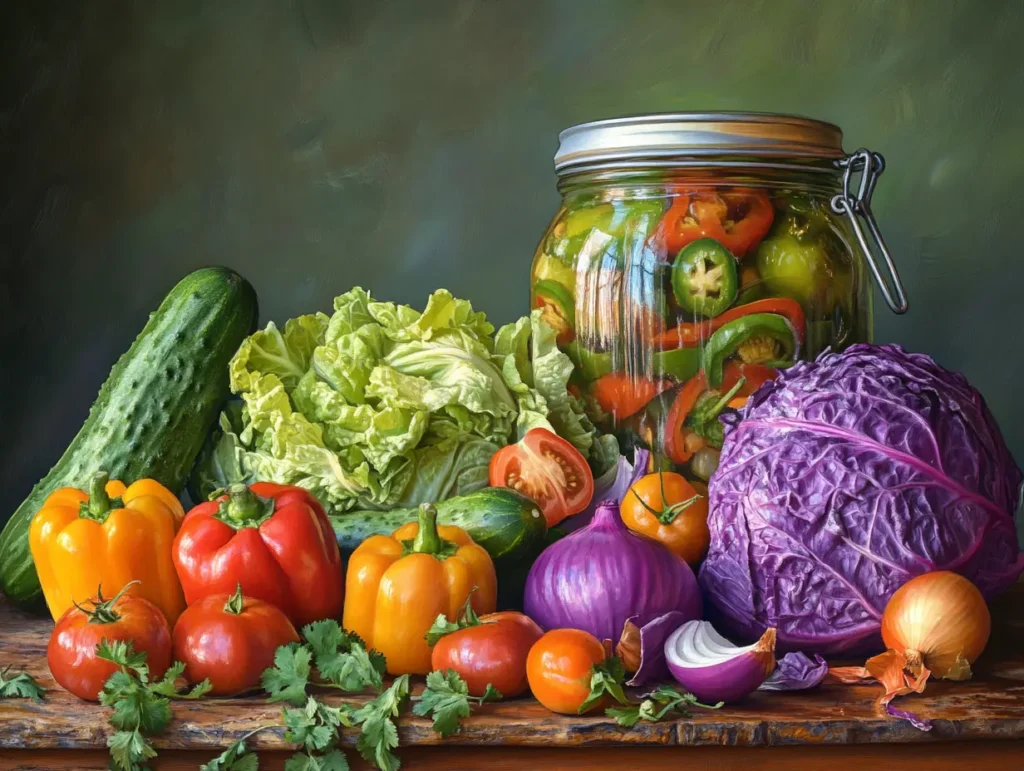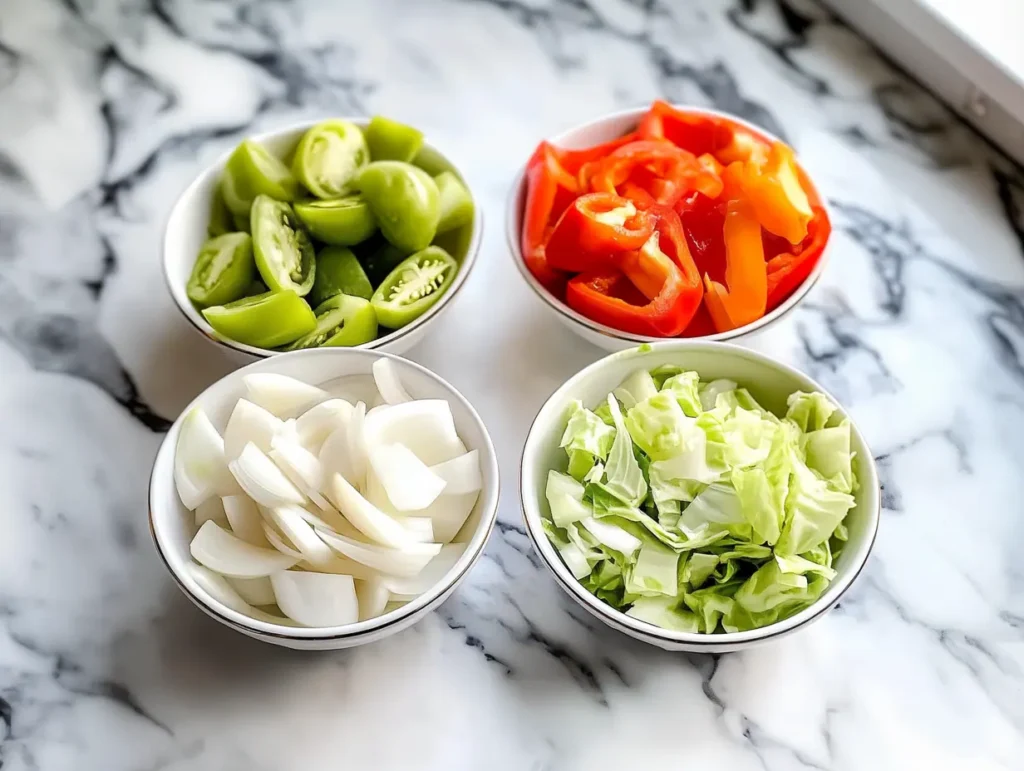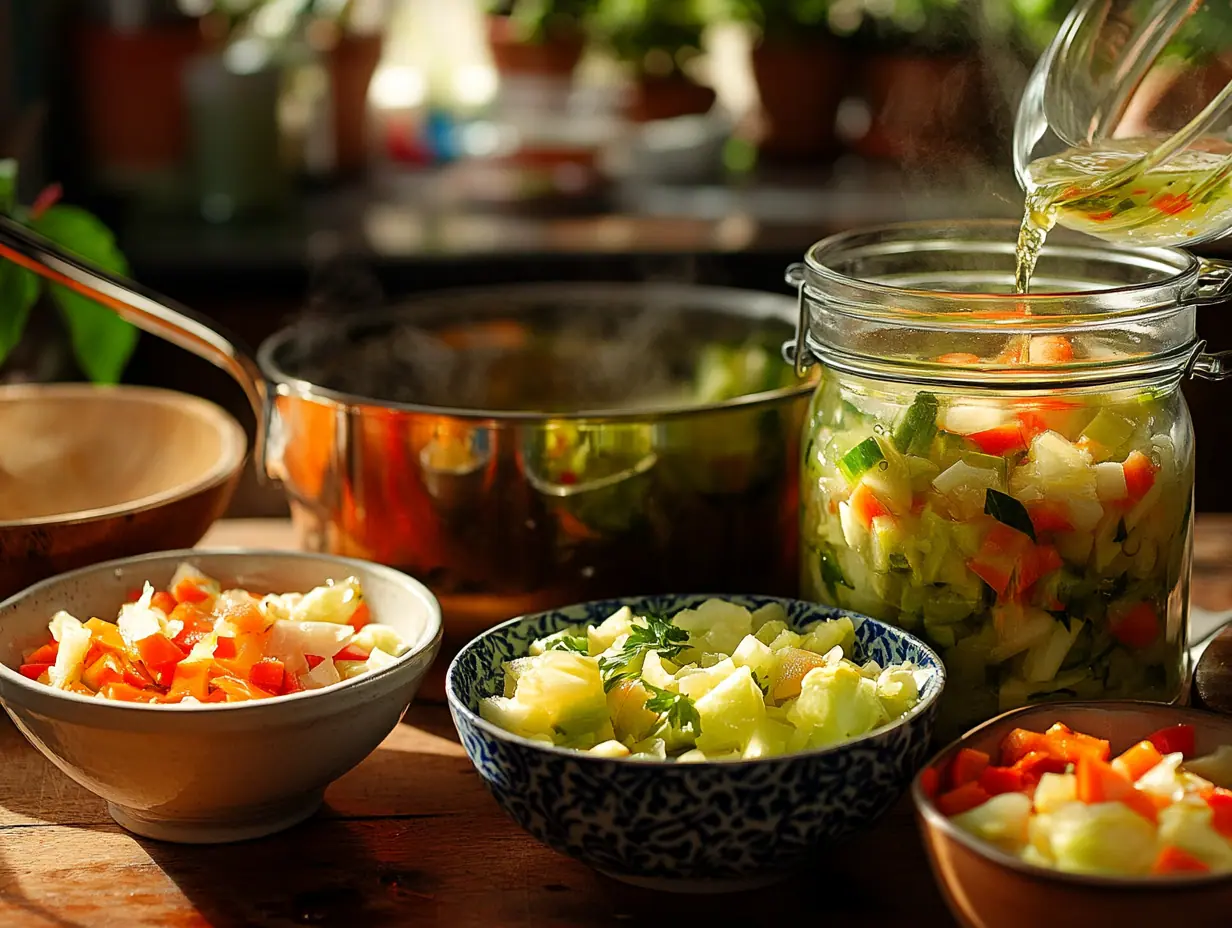Chow-chow is a beloved Southern pickled relish that combines various vegetables into a tangy, crisp condiment. This traditional preservation method has been passed down through generations, making it a staple in Southern cuisine. If you’ve ever wondered what this relish is made of, you’re about to discover the fascinating ingredients and preparation methods that make it so special.
For a detailed guide on making your own chow chow relish, explore this recipe here.
Essential Ingredients
The basic recipe typically includes:
- Green Tomatoes: Provide tartness and firm texture, essential for the relish’s crunch.
- Cabbage: Adds crunch and bulk, making the dish hearty.
- Bell Peppers: Contribute sweetness and vibrant color, enhancing the visual appeal.
- Onions: Deliver sharp flavor and aroma, balancing the sweetness of other ingredients.
- Cucumbers: Offer refreshing crunch, making the condiment more enjoyable.
- Salt: Essential for drawing out moisture and preserving the vegetables.
- Vinegar: Provides acidity, crucial for preservation and flavor.
- Sugar: Balances the acidity and enhances the overall taste.
- Pickling Spices: Common spices include mustard seeds, celery seeds, and red pepper flakes.
Additional Ingredients for Flavor
While the core ingredients are essential, many recipes include additional elements to enhance flavor:
- Garlic: Adds depth and a savory note.
- Carrots: Introduce sweetness and color.
- Cauliflower: Provides a unique texture and absorbs flavors well.
The Pickling Process
The magic happens during the pickling process. Here’s how it works:
- Vegetable Preparation: Start by washing and chopping the vegetables into uniform pieces to ensure even pickling.
- Salt Brining: Sprinkle salt over the chopped vegetables and let them sit for several hours or overnight. This process draws out moisture and helps preserve the vegetables.
- Vinegar Solution Creation: Combine vinegar, water, and sugar in a pot. The acidity of the vinegar is crucial for preservation and flavor.
- Spice Mixture Addition: Add pickling spices to the vinegar solution.
- Canning Methods: Fill sterilized jars with the vegetable mixture and pour the hot vinegar solution over them. Seal the jars and process them in a water bath to ensure they are shelf-stable.
Regional Variations
This relish varies significantly by region. Here are some popular variations:
Southern Style
The Southern version typically features:
- More Green Tomatoes: This gives it a tangier flavor.
- Sweeter Profile: Often includes more sugar to balance the acidity.
- Yellow Color from Turmeric: This is a hallmark of the Southern style.
Pennsylvania Dutch Style
This variation includes:
- Lima Beans: Adds protein and a different texture.
- String Beans: Provides a crunchy element.
- Carrots: Introduces sweetness and color.
New England Style
In New England, this condiment often includes:
- Green Peppers: For a slightly different flavor profile.
- Beets: Which add sweetness and a vibrant color.

Health Benefits and Nutritional Value
This pickled relish offers several health advantages:
- Rich in Probiotics: The fermentation process can promote gut health.
- Good Source of Fiber: The vegetables provide dietary fiber, aiding digestion.
- Low in Calories: A great condiment for those watching their calorie intake.
- Contains Beneficial Vitamins: Vegetables are packed with vitamins A, C, and K.
- Provides Minerals: Essential minerals like potassium and magnesium are present.
Nutritional Breakdown
Here’s a general nutritional breakdown for a 1-tablespoon serving:
- Calories: 10-15
- Total Fat: 0g
- Sodium: 100-200mg (varies based on salt used)
- Carbohydrates: 3-4g
- Fiber: 0.5g
- Sugars: 1-2g
How to Store and Preserve
Proper storage ensures longevity:
- Use Sterilized Jars: Always sterilize jars before filling them to prevent spoilage.
- Process in a Water Bath: This step is crucial for sealing the jars and ensuring they are shelf-stable.
- Store in a Cool, Dark Place: A pantry or cupboard is ideal for long-term storage.
- Refrigerate After Opening: Once opened, it should be kept in the refrigerator and consumed within 2-3 months.
Serving Suggestions and Pairings
This relish complements many dishes:
- Pinto Beans: A classic Southern pairing that enhances the flavor of the beans.
- Hot Dogs: Adds a tangy crunch to grilled hot dogs.
- Hamburgers: A unique topping that elevates the burger experience.
- Cornbread: A traditional Southern side that pairs beautifully with it.
- BBQ Sandwiches: Adds a zesty kick to pulled pork or brisket sandwiches.
Creative Uses
Beyond traditional pairings, consider these creative uses:
- Topping for Tacos: Adds a crunchy, tangy element to tacos.
- Mix into Potato Salad: Incorporate it for an unexpected twist.
- Garnish for Soups: Use as a garnish for bean or vegetable soups. For a hearty soup idea, learn about the ingredients in creamy salmon soup.
- In Salad Dressings: Blend into vinaigrettes for added flavor.
FAQs About Chow-Chow
What is the origin of this relish?
It originated as a preservation method for end-of-season vegetables. Its exact origins are debated, but it’s deeply rooted in Southern and Pennsylvania Dutch cuisine.
How long does homemade chow-chow last?
Properly canned versions can last up to one year when stored in a cool, dark place. Once opened, it should be refrigerated and consumed within 2-3 months.
Is this relish the same as traditional cucumber relish?
While it is a type of relish, it’s distinct from traditional cucumber varieties. It contains a broader variety of vegetables and has a unique spice blend.
Can you freeze it?
While freezing isn’t the traditional preservation method, it can be frozen for up to 6 months, though this may affect its texture.
What are the best vegetables to use?
The best vegetables include green tomatoes, cabbage, bell peppers, onions, and cucumbers. However, feel free to experiment with other vegetables like carrots and cauliflower.
How do you serve it?
It can be served as a condiment with meats, mixed into salads, or used as a topping for various dishes. It adds a tangy, crunchy element to any meal.
Tips for Making Perfect Chow-Chow at Home
Success factors include:
- Using Fresh, Crisp Vegetables: The quality of your vegetables will directly impact the flavor and texture.
- Proper Salt Ratios: Too much salt can make it inedible, while too little can lead to spoilage.
- Consistent Chopping Size: Uniform pieces ensure even pickling and a better texture.
- Correct Processing Time: Follow canning guidelines to ensure safety and longevity.
- Quality Vinegar Selection: Use a vinegar with at least 5% acidity for proper preservation.
Common Mistakes to Avoid
Watch out for these errors:
- Over-Processing Vegetables: This can lead to mushy results.
- Incorrect Salt Measurements: Too much salt can overpower the flavor, while too little can lead to spoilage.
- Improper Sterilization: Always sterilize jars and lids to prevent contamination.
- Wrong Vinegar Strength: Ensure you use vinegar with the right acidity for safe preservation.
- Inadequate Processing Time: Follow recommended processing times to ensure safety.
Seasonal Considerations for Making Chow-Chow
Best times to make it:
- Late Summer: When tomatoes and peppers are in abundance.
- Early Fall: Perfect for using up the last of the garden harvest.
- End of Growing Season: A great way to preserve excess vegetables.
- Before First Frost: Gather and pickle vegetables before the frost hits.
- During Vegetable Abundance: Take advantage of local farmers’ markets for fresh produce.
Modern Adaptations
Contemporary variations include:
- Spicier Versions: Adding jalapeños or habaneros for heat.
- Low-Sugar Options: Reducing sugar for a healthier version.
- Different Vinegar Types: Experimenting with apple cider or rice vinegar for unique flavors.
- Additional Vegetables: Incorporating seasonal vegetables like zucchini or radishes.
- International Fusion Flavors: Adding ingredients like ginger or soy sauce for a global twist.
Cultural Significance
This condiment represents:
- Food Preservation Heritage: A way to make the most of seasonal produce.
- Southern Cooking Traditions: A staple in Southern households, often passed down through generations.
- Community Gathering: Often made in large batches for family reunions and gatherings.
- Family Recipes: Each family has its unique take, making it a personal tradition.
- Sustainable Practices: Encourages the use of local and seasonal ingredients, reducing food waste.
Chow-Chow in Popular Culture
This relish has made its mark beyond the kitchen. It appears in various cultural references, including:
- Cookbooks: Many Southern cookbooks feature recipes, showcasing its importance in Southern cuisine.
- Food Festivals: It is often highlighted at food festivals celebrating Southern food traditions.
- Social Media: Food bloggers and influencers share their unique takes, introducing it to new audiences.

How to Make Chow-Chow at Home: A Step-by-Step Guide
If you’re inspired to make your own, here’s a simple recipe to get you started:
Ingredients
- 4 cups chopped green tomatoes
- 2 cups chopped cabbage
- 1 cup chopped bell peppers (any color)
- 1 cup chopped onions
- 1 cup chopped cucumbers
- 1/4 cup salt
- 2 cups vinegar (5% acidity)
- 1 cup sugar
- 1 tablespoon mustard seeds
- 1 tablespoon celery seeds
- 1 teaspoon turmeric
- 1 teaspoon red pepper flakes (optional)
Instructions
- Prepare the Vegetables: Wash and chop all the vegetables into uniform pieces. Place them in a large bowl.
- Brine the Vegetables: Sprinkle salt over the chopped vegetables and mix well. Cover the bowl and let it sit for 4-6 hours or overnight in the refrigerator. This process will draw out moisture.
- Make the Pickling Solution: In a large pot, combine vinegar, sugar, mustard seeds, celery seeds, turmeric, and red pepper flakes. Bring the mixture to a boil, stirring until the sugar dissolves.
- Combine and Cook: Drain the brined vegetables and rinse them under cold water to remove excess salt. Add the vegetables to the boiling pickling solution and cook for 10-15 minutes, stirring occasionally.
- Fill the Jars: Carefully ladle the hot mixture into sterilized jars, leaving about 1/2 inch of headspace. Wipe the rims of the jars with a clean cloth to remove any residue.
- Seal and Process: Place the lids on the jars and screw on the bands until they are fingertip-tight. Process the jars in a boiling water bath for 10-15 minutes to ensure they are sealed properly.
- Cool and Store: Remove the jars from the water bath and let them cool completely on a clean towel or cooling rack. Once cooled, check the seals. Store sealed jars in a cool, dark place.
Tips for Success
- Use Fresh Ingredients: The fresher your vegetables, the better your final product will taste.
- Experiment with Spices: Feel free to adjust the spices to suit your taste preferences.
- Label Your Jars: Don’t forget to label your jars with the date and contents for easy identification.
Conclusion
This pickled relish is more than just a condiment – it’s a testament to traditional food preservation methods and Southern culinary heritage. Understanding what it is made of helps appreciate the complexity and versatility of this beloved dish. Whether you’re a seasoned cook or new to Southern cuisine, making your own version is a rewarding way to connect with food traditions while creating something delicious.
By exploring the ingredients, preparation methods, and cultural significance, you can appreciate this unique condiment even more. So, gather your vegetables, grab your jars, and start your own adventure today!
Final Thoughts
As you embark on your chow-chow-making journey, remember that this condiment is not just about the ingredients; it’s about the memories and traditions that come with it. Each jar tells a story, whether it’s a family recipe passed down through generations or a new creation inspired by your culinary adventures.
Consider sharing it with friends and family, or even gifting jars during the holidays. It’s a wonderful way to introduce others to the flavors of Southern cuisine and the joy of homemade preserves.
Incorporating it into your meals can also inspire creativity in the kitchen. Use it as a topping for various dishes, or even as a secret ingredient in your favorite recipes. The possibilities are endless, and the tangy, crunchy flavor is sure to elevate any meal. For seafood pairings, learn how to cook and serve branzino.
So, whether you’re enjoying it straight from the jar or using it to enhance your culinary creations, this relish is a delightful addition to any kitchen. Happy cooking!

